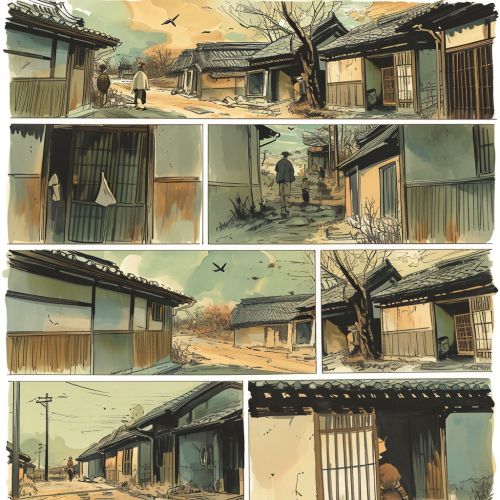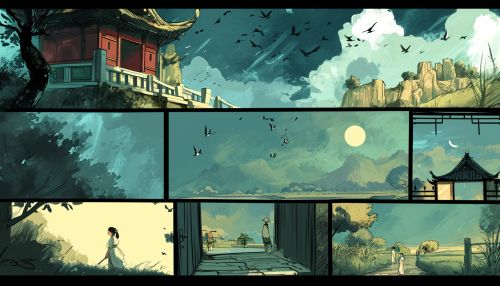Animation Storyboards
Introduction
Animation storyboards are a crucial tool in the production of animated films, television shows, and video games. They serve as a visual representation of the storyline, helping to guide the creative process from conception to completion. The storyboard is essentially a series of drawings, with accompanying notes, that depict the sequence of major events in the narrative. It is a critical step in the animation process, allowing animators, directors, and other members of the production team to visualize the story before actual animation begins.


History and Evolution
The use of storyboards in animation can be traced back to the early days of the Disney Studio. The studio began using storyboards in the 1930s during the production of its first full-length animated feature, Snow White and the Seven Dwarfs. The storyboard process was initially developed as a means of pre-visualizing the film, allowing the creative team to experiment with different narrative structures and visual styles before committing to the final animation.
Over the years, the use of storyboards has evolved and expanded. Today, they are used not only in animation but also in live-action filmmaking, advertising, and even in the design of complex interactive experiences such as video games and virtual reality applications.
Role in Animation Production
In the context of animation production, the storyboard serves several important functions. It provides a visual blueprint for the film or episode, helping to define the narrative structure, the pacing, the visual style, and the overall mood of the project. It also serves as a communication tool, allowing the director and the rest of the production team to share their vision with others involved in the project, including animators, sound designers, and post-production staff.
The storyboard process typically begins after the completion of the script. The storyboard artist, working closely with the director and the scriptwriter, translates the script into a series of visual panels. Each panel represents a key moment or scene in the story, with accompanying notes describing the action, the dialogue, and any special effects or camera movements.
Creation Process
Creating a storyboard for an animated project is a complex and multi-step process. It begins with the creation of a script, which outlines the narrative and the dialogue for the project. The script is then handed over to the storyboard artist, who begins to visualize the story in a series of rough sketches.
These initial sketches, often referred to as "thumbnails," are small, quick drawings that capture the essence of each scene. They are used to experiment with different compositions and camera angles, and to establish the basic sequence of events in the story.
Once the thumbnails are approved, the storyboard artist moves on to create more detailed drawings for each scene. These drawings, often done in pencil or digitally, provide a more accurate representation of what the final animation will look like. They include detailed notes on the action, the characters' expressions and movements, and the camera angles and movements.
The final step in the storyboard process is the creation of a "story reel" or "animatic." This is a rough version of the animation, created by scanning the storyboard drawings into a computer and timing them to the dialogue and sound effects. The story reel allows the production team to see how the story flows and to make any necessary adjustments before moving on to the actual animation.
Types of Storyboards
There are several types of storyboards used in animation production, each serving a different purpose. The most common types are:
1. Thumbnail Storyboards: These are small, quick sketches that are used in the early stages of the storyboard process. They allow the storyboard artist to experiment with different ideas and to establish the basic sequence of events in the story.
2. Presentation Storyboards: These are detailed, finished drawings that are used to present the story to the director, the production team, and other stakeholders. They provide a clear and accurate representation of what the final animation will look like.
3. Animatics: These are rough versions of the animation, created by scanning the storyboard drawings into a computer and timing them to the dialogue and sound effects. They allow the production team to see how the story flows and to make any necessary adjustments before moving on to the actual animation.
Importance in Animation
Storyboards play a crucial role in the animation process. They provide a visual blueprint for the project, helping to guide the creative process from conception to completion. They allow the production team to visualize the story, to experiment with different narrative structures and visual styles, and to communicate their vision to others involved in the project.
Without a storyboard, the production team would have no clear direction or plan for the animation. They would have to rely on verbal descriptions and written scripts, which can be open to interpretation and can lead to confusion and miscommunication. The storyboard provides a clear, visual guide that everyone on the team can understand and follow.
Conclusion
In conclusion, animation storyboards are an essential tool in the production of animated films, television shows, and video games. They provide a visual guide that helps to define the narrative structure, the pacing, the visual style, and the overall mood of the project. They also serve as a communication tool, allowing the director and the rest of the production team to share their vision with others involved in the project. Whether it's a blockbuster animated film or a small independent project, the storyboard is a critical step in the animation process.
